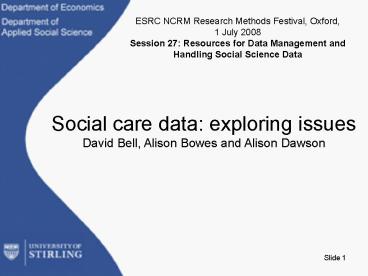OPERA - PowerPoint PPT Presentation
1 / 16
Title:
OPERA
Description:
... Family Resources Survey (FRS) and the Scottish Household ... FRS Variable label = De facto marital status. Value label information for DVMARDF. 1 = Married ... – PowerPoint PPT presentation
Number of Views:210
Avg rating:3.0/5.0
Title: OPERA
1
ESRC NCRM Research Methods Festival, Oxford, 1
July 2008 Session 27 Resources for Data
Management and Handling Social Science Data
Social care data exploring issues David Bell,
Alison Bowes and Alison Dawson
2
- This case study will
- Identify some of the substantive issues in
research on social care using the example of
unpaid care - Outline a microsimulation approach to
considering social care issues - Briefly discuss general data-related issues in
microsimulation - Describe data management operations that may be
required for microsimulation modelling, in
particular data fusion - Illustrate potential complexities with data
fusion using examples drawn from the Family
Resources Survey (FRS) and the Scottish Household
Survey (SHS)
3
Example unpaid care
- The continuing importance of unpaid care
- The balance of care
- Supporting unpaid carers
- The dynamics of unpaid caring
4
Key findings to date on unpaid care
- The impact of recent policy change
- Attitudes to caring
- Provision of care, proximity and education
- Significance of housing wealth
5
Some key issues
- Paying for care
- Impact of various co-payment regimes
- Impact of changing patterns of wealth
- Questions about the best expenditure of resources
- Supply of unpaid care
- Attitudes
- Education
- Migration of parents and children
- Delivery of unpaid care
- What carers do
- How to support carers
- Dynamics of unpaid care need for
microsimulation - Population movements
- Educational attainment
- New types of care provision
- Resources for unpaid care
6
Approach
- Using a microsimulation model (OPeRA Older
Peoples Resource Allocation Model) in the
context of Scottish demographic change - drawing on data from various censuses and
surveys, including FRS, census data, data on
actual caring histories over time (from Welsh
survey)
7
Microsimulation
- A microsimulation model is a model which uses
simulation techniques and which takes micro level
units as the basic unit of analysis when
investigating the effects of social and economic
policies - Dynamic microsimulation
- These models project samples of the population
forward in time, enabling, for example the
examination of future income distributions under
different scenarios
8
OPERA Key elements
9
OPERA - Potential outputs
- Individual life histories, including record of
events - Census on any type of event and calculation of
cost by local authority over user-determined
period - Preparation of budget for local authority based
on current care requirements and costs profile
10
Data related microsimulation issues
- What variables/behaviours to simulate?
- Over what period?
- What level of geographical disaggregation?
- Can all relevant information be found in a single
sample survey? - If not how do we form encompassing datasets?
11
Data management operations for microsimulation
modelling
- Cleaning data
- Checking data
- Recoding data
- Missing data / case selection
- Operationalising variables
- Linking data
- Matching data files together
- Data fusion
12
Data Fusion
Common variable(s)
Values of unobserved variable(s) are imputed for
recipient sample
Before data fusion No values for Var Y
After data fusion Imputed values for Var Y (not
true values)
Fusion proceeds by a number of (mostly
numerically intensive) procedures. The objective
is to define new variables whose properties
differ as little as possible from those of the
(unobserved) underlying data.
13
Potential difficulties with data fusion
Examples using FRS and SHS
- Family Resources Survey (FRS)
- Cross-sectional study, annual sampling frame
- Covers GB and N Ireland
- Disaggregation possible to Government Office
Regions - Observation unit households/families
- Interviews all adults in household
- 28,029 households in 2005/06
- 2,016 variables (253 derived)
- Scottish Household Survey (SHS)
- Cross-sectional study, two year sampling frame
- Covers Scotland only
- Disaggregation possible to Local Authority areas
- Observation unit individual,
households/families - Interviews householder or spouse plus one
random adult - 31, 013 households, 28,261 random adults in
sample to 2005/06 - 2,456 variables (80 administrative and derived)
14
Example 1 FRS and SHS common variables
Ethnicity
15
Example 2 FRS and SHS common variables
Marital status
FRS Variable label Marital status Value label
information for MS 1 Single, never married 2
Married and living with husband/wife 3 Married
and separated 4 Divorced 5 Widowed
SHS Variable label Marital status of the
HIH Value label information for hih_stat 1
Married 2 Cohabiting (living together) 3
Single / never been married 4 Widowed 5
Divorced 6 Separated
FRS Variable label De facto marital
status Value label information for DVMARDF 1
Married 2 Cohabiting 3 Single 4 Widowed
5 Divorced 6 Separated 7 Same sex couple
16
Summary
- Techniques such as microsimulation can play an
important part in considering substantive issues
in research on social care. - There are many relevant variables when modelling
social care. We identified only a subset of these
when considering the example of unpaid care. No
single sample survey contains all the variables
we would want to use. - We need to identify relevant sample survey
datasets and carry out data management operations
such as cleaning data, operationalising
variables and linking datasets prior to
modelling. - Metadata provides valuable information that
helps us to identify and address practical
problems in the data fusion processes necessary
to produce better microsimulation models






























